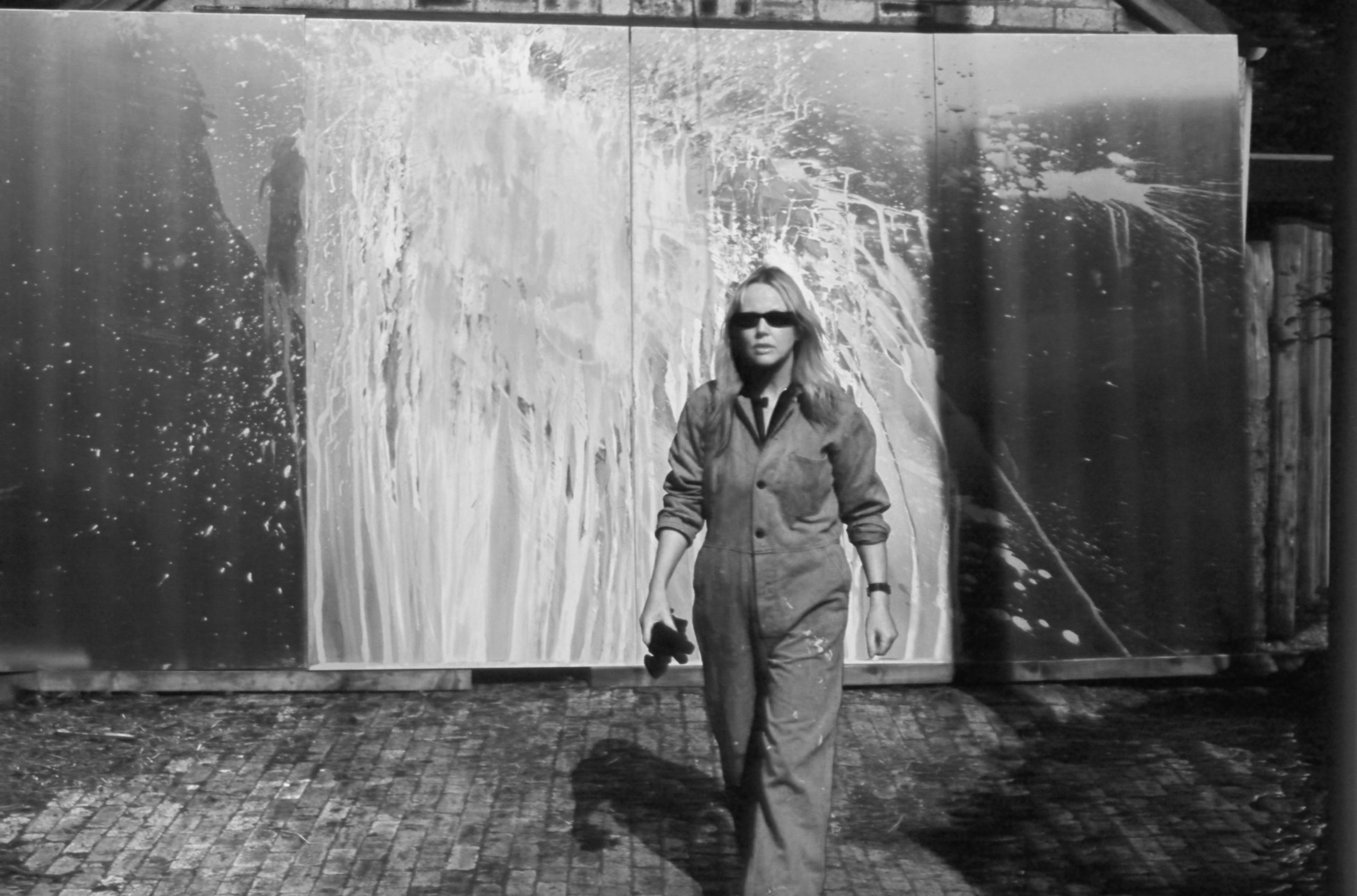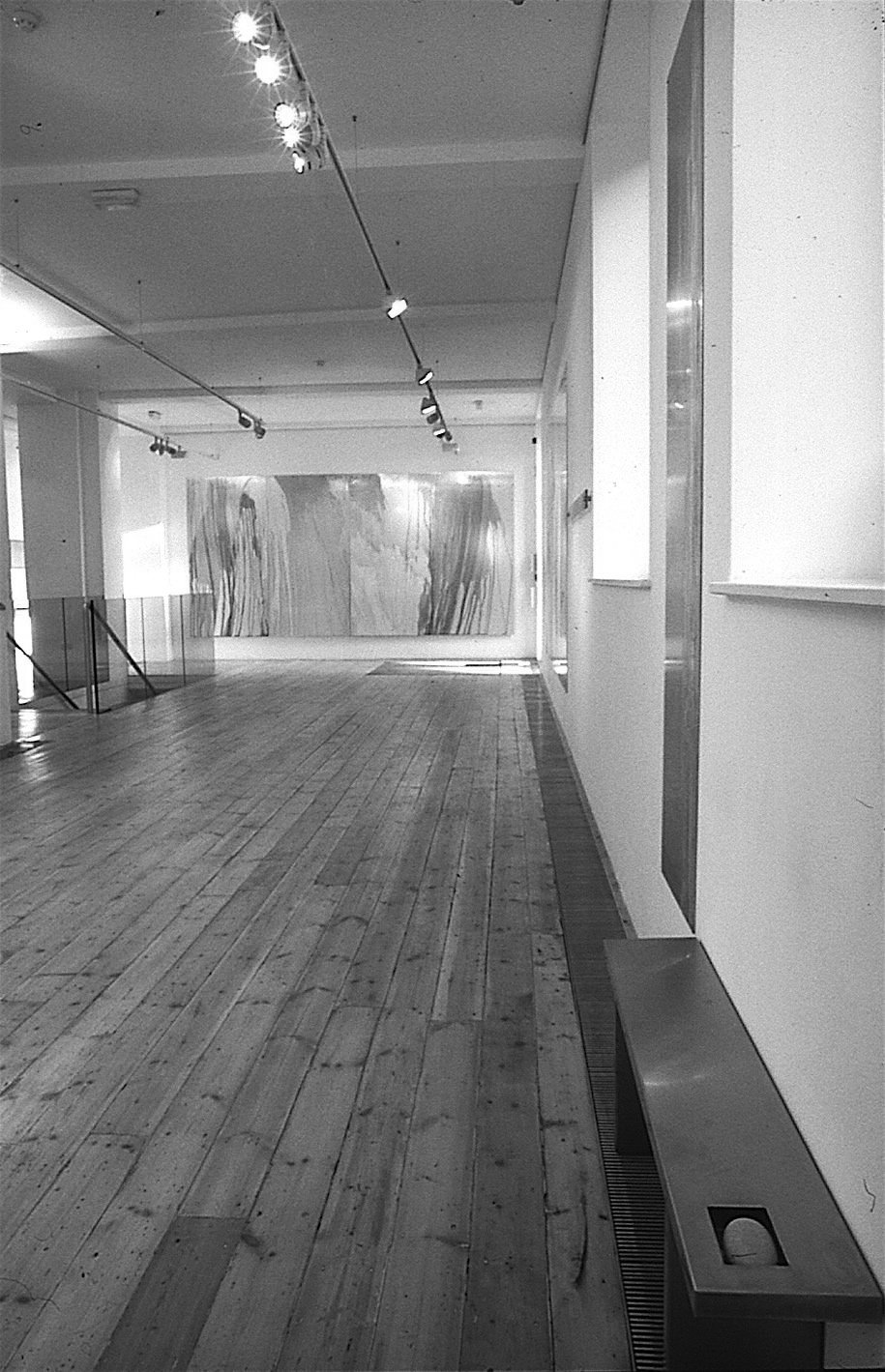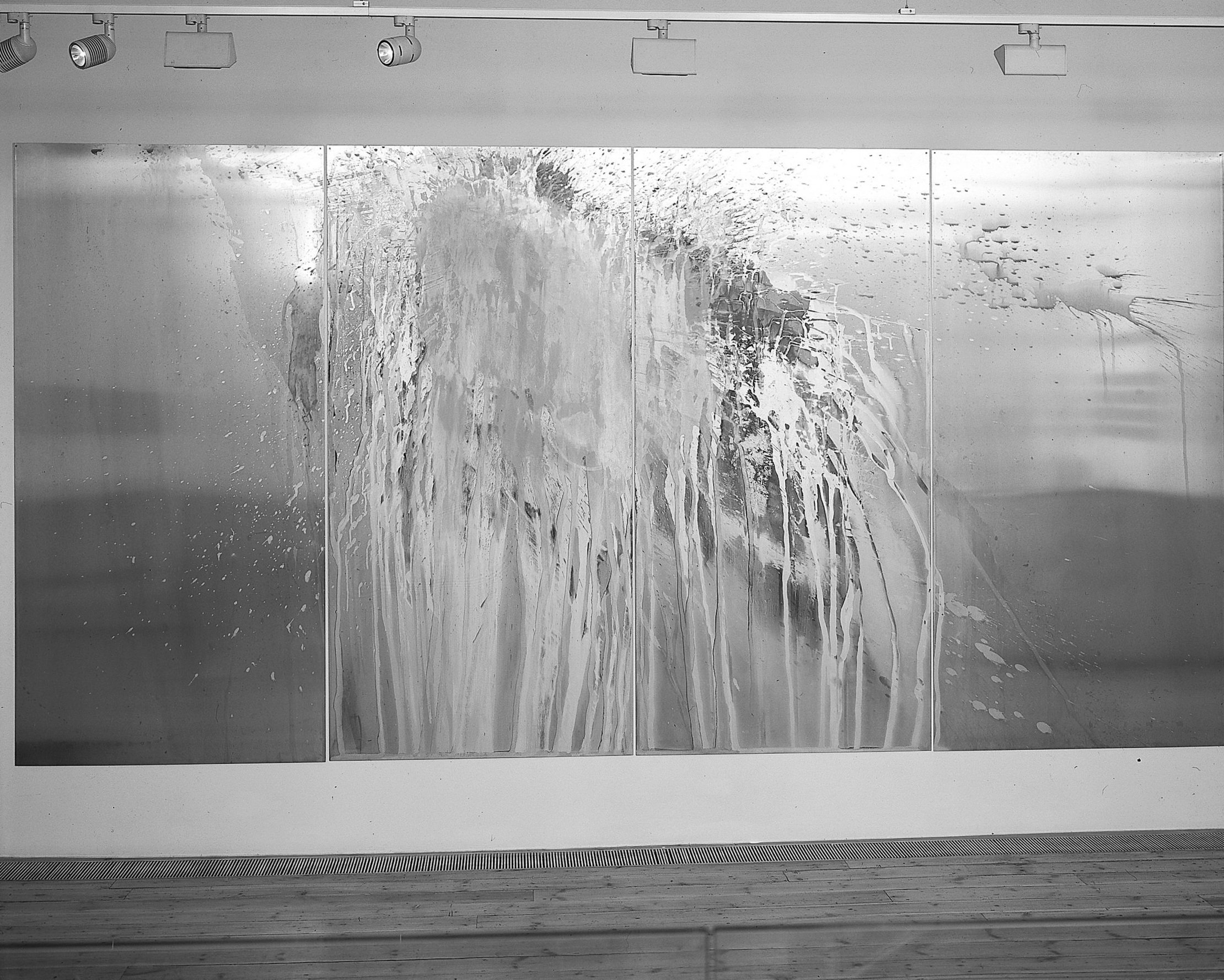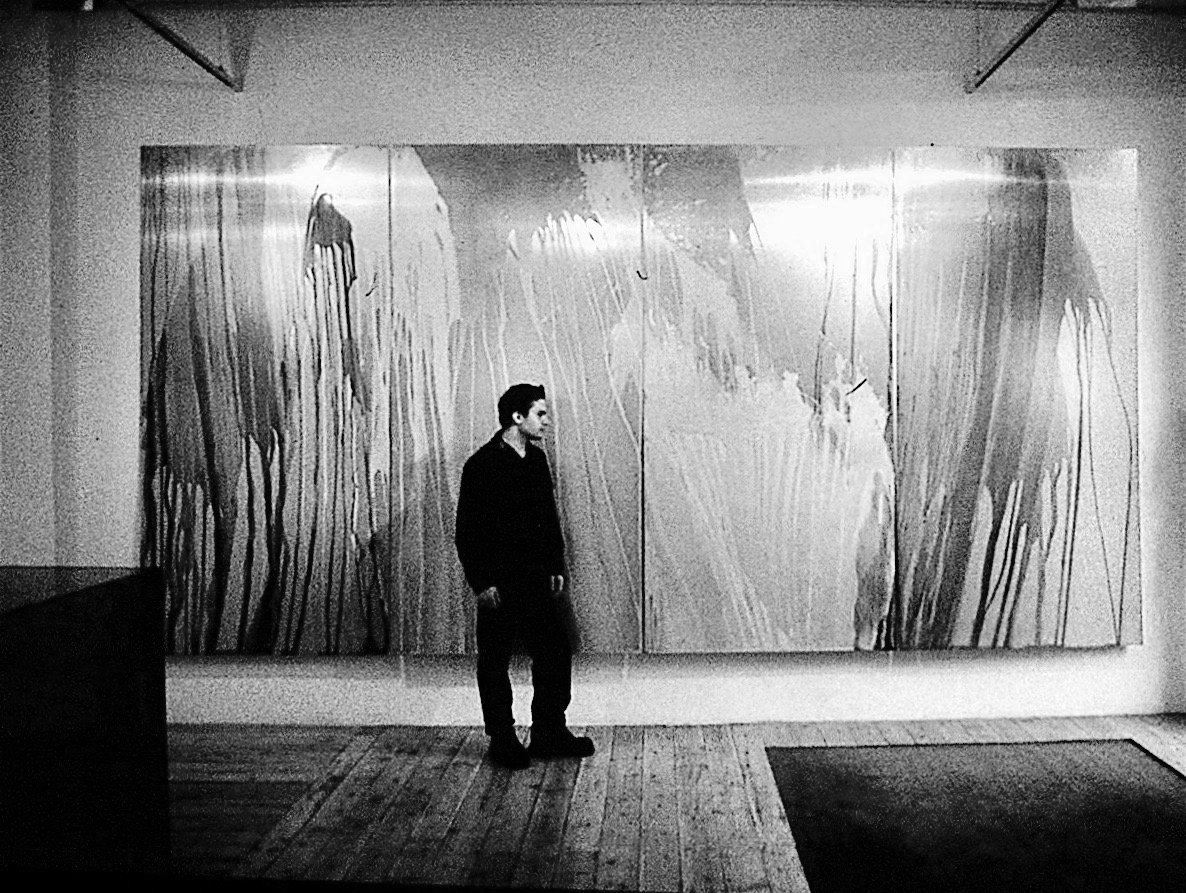Elizabeth Ogilvie's relation to the sea is permanent, fixed. But to equate life with water, geography with geology, place with subject is not the point.
Ogilvie is there within, without, outside, inside. Water is pretty much the same as art; it means very little as a category. When writing about her work five years ago it was already pointless to suggest that the work in any way illustrates. It is best to recognize that Ogilvie is always making an equivalent to her subject.
She uses text to place the situation, and her relation to poetry cuts out any question of representation or abstraction. Now Ogilvie makes an architectural equivalent and is so engaged with the solidity and fact of image; with the architectural interaction between the fluid and the permanent. With the tall text pieces, the imagery really does reside elsewhere, a halfway house between architecture's need to be real and functional and the artists desire to allude to illusion. So the equivalent of a Zen garden, with stones raked to imply movement, is more to the point, with weight and permanence indicating the flow of water in a contemplative garden of the mind, held still for ever.
Ogilvie makes a place within a place. Her architectural piece, the Guernica Project, glows and shimmers with Deephaven Hangar like an expanded piece of cryptonite. But while architects see themselves as artists, artists wish their work to have real function, and for the main part of the 20 th century the artist also questions where the edge of a work stops and where the surrounding influence of place starts.
But it goes further in relation to poetry. In the interaction between words and form, the water carries that strange relation between weight and disappointment or disappearance. What form to give the words? What weight to give the etched language? How to make sure that the work does not ground itself and hit rock bottom, the metaphor extended through selflessness? Poetry does the job more quickly, but Ogilvie's recent work has become increasingly sophisticated. In a bid to pare down the information and play with a permanent sense of time and wonder, she uses material that ranges from liquid to solid, shiny to tough, both still and slippery.
Often for an artist it is difficult to work out the relation between the doing, making and any effect the work may have. Somehow, time spent, whether laboriously or alchemically, allows contact of sorts with the weight of understanding. It is impossible to tell in the transition from one language to another, or to gauge how something might appear; yet the physical engagement means that the artist puts off the overview and apparent understanding.
It is advantageous to step back and consider, however, the relationship between the artist and her subject. Water, like art, means everything. In some way at a certain level, it is recognizable, whether salt, fresh, tap, puddle, bottle, flood, well, radiator, heavy, loch, oasis, river, lake, sea, or ocean. It is wet - yet as limitless as the sky. Art, too, carries that strange relation to the world. It can seep through the cracks of everyday life to apparently function differently - but is still art, with the strange formal limitation but also with the expansive enormity of being absolutely everything. Ogilvie recognizes the scale of ambition and also the limitation of such a generalized subject. She therefore engages any practices and processes in an attempt to produce an equivalent for these concerns; nature, movement, fact, intervention, place - the subject lies like an unconscious leit motif beside the artist throughout her working life.
It is all about being from Scottish islands, about abandonment, relation to the sea, land coast, emptiness, economic decline, exclusions, the generally unromantic, but nonetheless real undertow of a working environment, run down and depressed, where the industry, shipping, and fishing have moved elsewhere or gone nowhere. And yet it is still about living by the sea with seals bobbing past the lighthouse. Such knowledge and such unconscious involvement is there.
Ogilvie used, meticulously and obsessively, to draw fronds from the depths. She would bring them up flat to the surface, like a mermaid brushing her tresses, painstakingly capturing the movement and detail of the seaweed. Instead of moving deliberately in a formal or youthful activity in which something made last month is already useless and out of date, Ogilvie finds a way of working at one point. She puts it down again and so brings he entire range of approach along with her.
Like a complicated back stitch, movement can be shown, water can ripple, but never does a perspectival view enter the work. The relation between the illusion of water and surface in the recent caustic process is one of looking across the subject, where the water lines reaffirm the surface itself and chemical sits on the surface, suggesting almost deep space, with a constant splatter, drip, splat.
Ogilvie is relaxed and adamant in her range of material but maintains a strong relationship to sheer physicality; pipe, engraved poetry or poured matter maintains the factual presence. The swept swathes of stones in Japanese Temple gardens with the illusion of running water raked across the surface of dead weight, carries exactly the contradiction between movement and permanence. The adage of something not working when the viewer is out of the room does not apply here. The garden of the mind, or, in Ogilvie's case the shallow pockets of swathes of activity and poetic suggestion, carry their own logic and sense of permanence. Sculptural virtuosity combines with work which is still somehow two dimensional, as Ogilvie traps the swell in the equivalent of a relief: the edge holding the flow for all time.
In the recent poured engraving process pieces, there is the pull between deliberate control and apparent abandon - a particularly strong 20th century preoccupation. Some artists still wish to turn their backs, then turn around again to find or see something different. The wash of material that eats away at the surface also sees the artist acting alchemist where elements are placed on the edge of the surface, and left to interact with each other. Oglvie stays at the edge of the picture, like a flat earther overseeing the oceans, seas, and rivers of the world as they break, merge, and mass. She tips the surface slightly for the liquid to take effect, affecting the direction but not the detail, until fluidity and time are not illustrated but shown as fact. There is also something of the photographic process about this - the side of a piece of film carrying the faint sense of emulsion having been etched into by the light. The movement of the liquid across the surface is held within the frame as Ogilvie charts our relation to the sea from both inside and outside the subject.
Ogilvie has always made larger pieces as if she too wishes to be immersed in the subject. The recent piece installed in a huge hangar high up in Scotland also brings water, black and some dyed dark red, into the equation. The piece sets up a reflective illusion of depth and weight with the many rows of metal panels suspended in the phalanx above. The relation between time and comprehension is crucial here in that the work is meant to be contemplative. All her work needs to be considered as having time on its side. This may sound like truism, but much art is instant and wishes to be so. On the other hand, being neither abstract nor directly diadactic, such a general and generous subject sits like an overcoat, or cape, on the shoulders of her practice. Time spent looking at this work is not about the pursuit of knowledge, reason, or even meaning, as it is divorced from the give and take of information.
— Sacha Craddock
Perspext (detail)
Collaboration with poet Douglas Dunn
Salt crystals, water, aluminium trays







